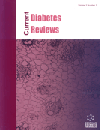- Home
- A-Z Publications
- Current Diabetes Reviews
- Previous Issues
- Volume 19, Issue 1, 2023
Current Diabetes Reviews - Volume 19, Issue 1, 2023
Volume 19, Issue 1, 2023
-
-
Diagnostic Dilemmas and Current Treatment Approaches in Latent Onset Autoimmune Diabetes in Adults: A Concise Review
More LessAuthors: Lakshmi Chandran, Ankul Singh S. and Chitra VellapandianLatent Onset Autoimmune Diabetes in Adults (LADA) is an autoimmune disorder between T1DM and T2DM and is often misdiagnosed as T2DM due to its late-onset. The disease is characterized by β-cell failure and slow progression to insulin dependence. Early diagnosis is significant in limiting disease progression. C-peptide levels and autoantibodies against β-cells are the most critical diagnostic biomarkers in LADA. The review Read More
-
-
-
Sugar Consumption Pattern among Cardiometabolic Risk Individuals: A Scoping Review
More LessAuthors: Wan L. Chiang, Azrina Azlan and Barakatun-Nisak Mohd YusofBackground: The global prevalence of noncommunicable diseases has risen rapidly over the past decade. Research has focused on dietary management, particularly dietary sugar, to prevent and treat noncommunicable diseases. Objective: This study undertakes a scoping review of research on the impacts of dietary sugar on cardiometabolic related health outcomes. Methods: Ovid Medline, Scopus and Web of Scien Read More
-
-
-
Maturity-onset Diabetes of the Young (MODY) in Pregnancy: A Review
More LessAuthors: Agata Majewska, Paweł Stanirowski, Mirosław Wielgoś and Dorota Bomba-OpońHyperglycaemia in pregnancy is one of the most common complications of pregnancy and is generally diagnosed as gestational diabetes mellitus (GDM). Nevertheless, clinical symptoms of hyperglycaemia in pregnancy in some cases do not match the clinical manifestations of GDM. It is suspected that 1-2 % of women diagnosed with GDM are misdiagnosed maturity-onset diabetes of the young (MODY). MODY often has a Read More
-
-
-
Diabetic Ketoacidosis (DKA), a Leading Risk Factor for Mucormycosis (Black Fungus), during the Era of Coronavirus Disease-2019 (COVID-19): An Overview
More LessAuthors: Nadeem Rais, Rizwan Ahmad, Akash Ved, Kehkashan Parveen, Darakhshan G. Bari and Om PrakashIntroduction: Diabetes mellitus (DM) and steroid medication, coincided with coronavirus disease 2019 (COVID-19), results in a weakened immune system, allowing some commonly found pathogens to become more harmful. Mucormycosis (black fungus) is a type of opportunistic infection caused by fungi belonging to the Mucorales family. DM is the most prominent risk factor for mucormycosis. Excessive blood sugar and d Read More
-
-
-
Diabetes Mellitus and Bell’s Palsy
More LessAuthors: Iliana Stamatiou, Stella Papachristou and Nikolaos PapanasThe aim of the present brief review was to discuss Bell’s palsy (BP) in diabetes mellitus (DM). The risk of BP is increased in DM. DM subjects with BP are more prone to severe facial nerve degeneration. Further characteristics of BP in DM include a) infrequent taste impairment; b) more frequent and more marked facial nerve subclinical electrophysiological impairment; c) more frequent Blink reflex impairment; d) potentially conc Read More
-
-
-
Histological Manifestations of Diabetic Kidney Disease and its Relationship with Insulin Resistance
More LessHistological manifestations of diabetic kidney disease (DKD) include mesangiolysis, mesangial matrix expansion, mesangial cell proliferation, thickening of the glomerular basement membrane, podocyte loss, foot process effacement, and hyalinosis of the glomerular arterioles, interstitial fibrosis, and tubular atrophy. Glomerulomegaly is a typical finding. Histological features of DKD may occur in the absence of clinical man Read More
-
-
-
Sociodemographic and Diabetes-related Risk Factors in San Diego County, California
More LessAuthors: Ali M. Alfalki and Ziyad Tariq MuhseenBackground: The research information would enable clinicians and public health professionals to formulate proper interventions for diabetic people according to age, gender, and race. Objective: The aim of the study was to investigate the relationship between diabetes-related mortality, hospitalization and emergency department discharge, and sociodemographic characteristics, in addition to age-standardized mortality r Read More
-
-
-
New Association Between Diabetes Mellitus and Pancreatic Cancer
More LessBackground: Diabetes mellitus is a global issue that has affected the lives of many people all over the world. This disorder, which is also called the mother of all diseases, possesses high pathogenicity and results in the emergence of many disorders. One of the known correlated diseases is pancreatic cancer which can be accompanied by diabetes mellitus. Therefore, finding the association between these diseases and com Read More
-
-
-
Treatment Management of Diabetic Wounds Utilizing Herbalism: An Overview
More LessAuthors: Priya Kumari, Shaweta Sharma, Pramod K. Sharma and Aftab AlamBackground and Objectives: Diabetes Mellitus, commonly known as DM, is a metabolic disorder which is characterized by high blood glucose level, i.e., chronic hyperglycemia. If it is not managed properly, DM can lead to many severe complexities with time and can cause significant damage to the kidneys, heart, eyes, nerves and blood vessels. Diabetic foot ulcers (DFU) are one of those major complexities which affect around 1 Read More
-
Volumes & issues
-
Volume 21 (2025)
-
Volume 20 (2024)
-
Volume 19 (2023)
-
Volume 18 (2022)
-
Volume 17 (2021)
-
Volume 16 (2020)
-
Volume 15 (2019)
-
Volume 14 (2018)
-
Volume 13 (2017)
-
Volume 12 (2016)
-
Volume 11 (2015)
-
Volume 10 (2014)
-
Volume 9 (2013)
-
Volume 8 (2012)
-
Volume 7 (2011)
-
Volume 6 (2010)
-
Volume 5 (2009)
-
Volume 4 (2008)
-
Volume 3 (2007)
-
Volume 2 (2006)
-
Volume 1 (2005)
Most Read This Month
Article
content/journals/cdr
Journal
10
5
false
en


